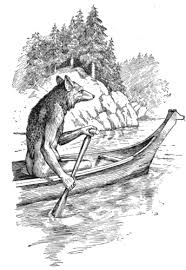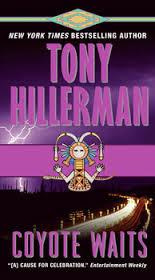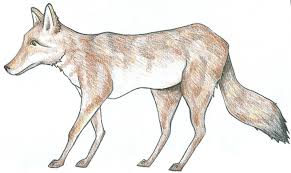 You may not want to run into this guy anytime soon. I first presented this post in 2015.
You may not want to run into this guy anytime soon. I first presented this post in 2015.
The Coyote myth is well known in many Native American cultures, especially out here in the western U.S. In the Creation stories of some tribes he represents the Creator himself, but for the most part Coyote is known as a messenger, a trickster, or a clown. In the latter guise, he may begin by entertaining folks but ultimately tricking them and stealing their stuff.
While most representations of Coyote show him as an actual coyote—often standing upright—he is said to be a shape-shifter. He might appear as other animals, or even as a handsome young man, prone to seducing unsuspecting young women. (In my horror novel, The Modoc Well, my nasty demon does exactly that, first luring them in and then—after changing back to his demon form—killing his female victims.)
Coyote can be noble, or he can be mean. He could fight monsters, or be the monster himself and bring harm to people. In some stories, he can induce others to perform nasty deeds.
A VISIT TO THE FOURTH WORLD
 Coyote is especially prominent in the Navajo culture. In my satirical science fiction novel, Bicycling Through Space and Time, my character, Jack Miller, rides his alien-enhanced mountain bike into the darnedest places. Chapter 22 finds him in the Fourth World of the Navajo (we are in the Fifth World), bemused as ever. As he gazes around him at the oddly colored landscape, he is startled by a voice. Here is the scene:
Coyote is especially prominent in the Navajo culture. In my satirical science fiction novel, Bicycling Through Space and Time, my character, Jack Miller, rides his alien-enhanced mountain bike into the darnedest places. Chapter 22 finds him in the Fourth World of the Navajo (we are in the Fifth World), bemused as ever. As he gazes around him at the oddly colored landscape, he is startled by a voice. Here is the scene:
“Looks really odd, doesn’t it?” a raspy voice from behind me said. “Something will have to be done about separating the blue and the black and putting order into this chaos.”
Preoccupied as I was, the voice nearly sent me jumping out of my bike shoes. I spun around and found myself face to face with a grinning coyote, who stood on his hind legs.
“Did you say that?” I asked.
The coyote looked around. “Well, who the heck else?” he replied. “You see anyone I don’t?”
“Guess not. But—”
“Oh bother!” the coyote suddenly exclaimed. “Locust stew and badger droppings. I can’t believe what I forgot to do. It’s always something, right?”
“What are you talking about?”
“You go ahead and have a look around. I’ll catch up in a while.”
“Wait a minute—!”
But he was gone, just like that. It happened so fast that I’m not sure if he winked out, faded away, dissolved, or what. It was weird, to say the least; but weird was commonplace now, wasn’t it?
WRITERS DO INFLUENCE READERS
As Jack contemplates his unusual but compelling surroundings, the coyote returns, and our traveler is about to get a grand tour not only of the Fourth World, but of Navajo mythology in general. I’ll present some of those scenes shortly. But what motivated me to write about this? That’s easy: Tony Hillerman.
 Prior to his death in 2008, Hillerman wrote an outstanding series of mysteries featuring Joe Leaphorn and Jim Chee, both of whom work for the Navajo Tribal Police. (His daughter, Anne Hillerman, has continued the series.) In addition to solving the crimes, Hillerman offers remarkable insight of this tribe’s fascinating culture. I’m currently re-reading the series, and Book Ten is titled—appropriately—Coyote Waits.
Prior to his death in 2008, Hillerman wrote an outstanding series of mysteries featuring Joe Leaphorn and Jim Chee, both of whom work for the Navajo Tribal Police. (His daughter, Anne Hillerman, has continued the series.) In addition to solving the crimes, Hillerman offers remarkable insight of this tribe’s fascinating culture. I’m currently re-reading the series, and Book Ten is titled—appropriately—Coyote Waits.
So after the coyote suddenly reappears, scaring the crap out of Jack, he offers to show our hero around. Here is the scene:
“Anyway,” Coyote said, “I give a pretty good tour. Let me show you around this place.”
“Yeah, sure, that’d be…”
I looked at him suspiciously. This was Coyote, and in Navajo legend he didn’t have the best reputation. Oh, he wasn’t a monster or anything like that; he wasn’t going to suck out your brains or do Nazi-style surgery on you or your children. He was more a troublemaker, a trickster, a real mamser. If there was a used-car lot in the Fourth World, Coyote would be out there wearing a smile and a plaid sport coat and writing the deals. In other words, to the Navajo he was a royal pain-in-the-ass. So you can understand my reluctance.
“Something wrong?” he asked.
“Just wondering what this was going to cost me.”
His grin grew wider. Jeez, those were nasty teeth! “So, my notoriety precedes me. Not to worry, friend. Being a trickster is fun, but it can get boring sometimes, too. We don’t get many visitors here, and showing you around will be a nice change of pace. What do you say?”
Okay, why not? The guy didn’t seem that bad, and I could always keep an eye on him.
“Lead on, MacDuff,” I said, which made him scratch his fuzzy head.
ONCE A TRICKSTER…

This Coyote greets visitors at our front door.
The tour through Navajo mythology commences in the next chapter, with Coyote performing some tricks that are actually part of Navajo myth. Jack even gets to meet some Navajo gods. But true to form, Coyote suddenly winks out—with Jack’s bike in tow. Ultimately, with the assistance of one of the aforementioned gods, Black Body, Jack catches up to Coyote, who is having trouble staying on the bike. Here is the scene:
“There’s the little shitball (!!) now,” Black Body said. “Your thing is as good as returned to you.”
Coyote saw us and waved. “Hey, Jackie and Blackie!” he called, looking smug over his creative prowess. “Now you didn’t think I was going to keep this, did you? Naah, I was just having a little fun…”
We had landed while he was talking; glad to get that sunbeam out of my crotch. Black Body did something with his hands, and the sunbeam re-formed into a big moccasined foot, which chased after Coyote, then caught him full in the rear end. He flew high and far, and on his downward arc he let out a scream that sounded like aaah-hoo-hoo-hooey, the same as Goofy does when you push him off a cliff or out a window. I didn’t even see where he landed.
 So as the Dineh (Navajo for People) make ready to rise up into the Fifth World, Jack rides out of the Fourth World in a hurry.
So as the Dineh (Navajo for People) make ready to rise up into the Fifth World, Jack rides out of the Fourth World in a hurry.
I find the myths and legends of this continent’s indigenous People fascinating and will continue to study more as I ease into my dotage. If you’re interested at all, Tony and Anne Hillerman’s Leaphorn and Chee novels are great for learning about the culture of the Navajo—amid a few juicy murders that need solving!
